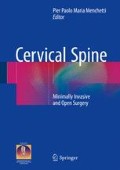Abstract
It is generally believed that the modulus of elasticity is a major criterion to anticipate the success of an implant material. Often, this elasticity is only partially addressed, since the geometrical data are omitted. For axial and bending stiffness the cross section’s area and area moment of inertia must also be taken into consideration. An additional criterion in respect to the bony anchorage of vertebral cages is being presented, which is the induced lateral strain εq = ν · ε. This strain must be sufficiently similar in order to prevent detrimental micromotion. A unique and ideal material stiffness out of the available biomaterials cannot be formulated. But a set of additional criteria for a successful bony anchorage can be listed, such as friction behavior at the interface or material with a potential for stimulating bone ingrowth. The evaluation of stiffness cannot avoid the necessity to carry out numerical analysis, experimental tests with preferably human specimen or careful clinical observations.
Access this chapter
Tax calculation will be finalised at checkout
Purchases are for personal use only
References
Yang H, et al. Micromechanics of the human vertebral body for forward flexion. J Biomech. 2012;45(12):2142–8.
Ferguson S, Steffen T. Biomechanics of the aging spine. Eur Spine J. 2003;12 Suppl 2:S97–103.
Currey J. The mechanical adaptations of bones. Princeton: Princeton University Press; 1984.
White AA, Panjabi MM. Clinical biomechanics of the spine. Philadelphia: J.B. Lippincott Company; 1990.
Thaler M, et al. Footprint mismatch in total cervical disc arthroplasty. Eur Spine J. 2013;22:759–65.
Banse X, Sims TJ, Bailey AJ. Mechanical properties of adult vertebral cancellous bone: correlation with collagen intermolecular cross-links. J Bone Miner Res. 2002;17(9):1621–8.
Grob D. A comparison of outcomes of cervical disc arthroplasty and fusion in everyday clinical practice: surgical and methodological aspects. Eur Spine J. 2010;19:297–306.
Nabhan A. Assessment of adjacent-segment mobility after cervical disc replacement versus fusion: RCT with 1 year’s results. Eur Spine J. 2011;20:934–41.
Wolff J. Das Gesetz der Transformation der Knochen. Hirschwald; Berlin; 1892. Translated by Maquet P, Furlong R. The Law of Bone Remodelling. Springer: Berlin/Heidelberg; 1986.
Carter DR, et al. Relationships between loading history and femoral cancellous bone architecture. J Biomechanics. 1989;22(3):231–44.
Kurtz SM, Devine JN. PEEK biomaterials in trauma, orthopedic and spinal implants. J Biomaterials. 2007;28(32):4845–69.
http://www.aerospacemetals.com/titanium-ti-6al-4v-ams-4911.html
Petersen RC. Bisphenil-polymer/carbon-fiber-reinforced composite compared to titanium alloy bone implant. Int J Polym Sci. 2011;2011, Article ID 168924, 11 pages.
Datasheet Bionate® (2009) by DSM PTG, 2810 7th Street, Berkeley, CA 94710
Datasheet Carbosil® (2009) by DSM PTG, 2810 7th Street, Berkeley, CA 94710
Martínez-Vázquez FJ, et al. Improving the compressive strength of bioceramic robocast scaffolds by polymer infiltration. Acta Biomater. 2010;6:4361–8.
Polikeit A, et al. Factors influencing stresses in the lumbar spine after the insertion of intervertebral cages: finite element analysis. Eur Spine J. 2003;12:413–20.
® Bionate and Carbosil are trademarks of DSM PTG
Author information
Authors and Affiliations
Corresponding author
Editor information
Editors and Affiliations
Rights and permissions
Copyright information
© 2016 Springer International Publishing Switzerland
About this chapter
Cite this chapter
Freudiger, S. (2016). Biomechanical Engineering in Choice of Different Stiffness Material. In: Menchetti, P. (eds) Cervical Spine. Springer, Cham. https://doi.org/10.1007/978-3-319-21608-9_14
Download citation
DOI: https://doi.org/10.1007/978-3-319-21608-9_14
Publisher Name: Springer, Cham
Print ISBN: 978-3-319-21607-2
Online ISBN: 978-3-319-21608-9
eBook Packages: MedicineMedicine (R0)

